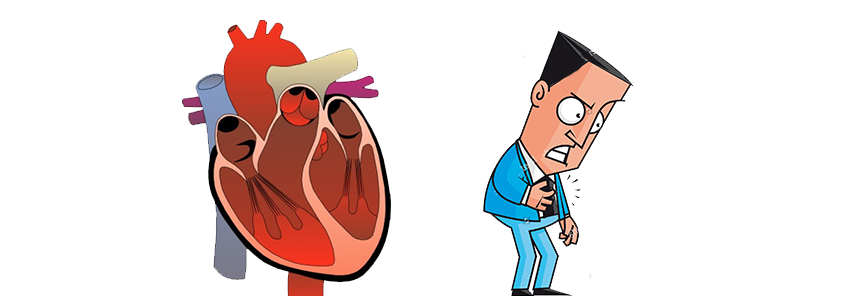Heart Attack

- Age: As you get older, your risk of a heart attack goes up. More than 80% of people who die of heart disease are 65 or older.
- Sex: Men have a greater risk of heart attack than women do, and they have attacks earlier in life. However, older women who have a heart attack are more likely to die earlier than older men with heart attacks.
- Family history: If you have a close relative who developed heart disease prematurely—before 55 for men and 65 for women—you have higher chances of getting it.
- Ethnicity: Compared to whites, African-Americans, Mexican, Indians, and some Asian Americans have higher risk of heart disease. But this may be related to higher prevalence of other risk factors.
- Smoking: Your heart attack risk is two to four times higher if you smoke cigarettes. Smoking damages the arteries, contributes to high cholesterol and high blood pressure and raises the risk of blood clots.
- High Cholesterol: If your total cholesterol and particularly LDL cholesterol is high, your risk of heart disease and thus heart attack increases.
- High Blood Pressure: It is a common problem in adults, which makes your heart work harder to pump blood. It increases your risk of stroke, heart attack, kidney failure, and heart failure.
- Diabetes mellitus: If you have diabetes, particularly uncontrolled diabetes, your chances of having heart attack and dying from it is increased.
- Obesity: People who have excess body fat — especially around the midsection — are more likely to develop heart disease or have a stroke even if they have no other risk factors.
- Sedentary lifestyle: If you do not exercise at least 30 minutes most days of the week, your chances of having heart attack will be more.
- Chest discomfort is the most common symptom of a heart attack. The discomfort may feel like a pressure, tightness, squeezing sensation on the left side the chest that may spread to the neck, jaw and left arm. The pain might be intermittent lasting few minutes or continue for longer period depending on the degree of blood flow blockage and muscle death. People with diabetes can have a heart attack without chest pain as the nerves supplying the heart are damaged in diabetes.
- Cold Sweat: Sudden excessive sweating is another symptom of heart attack.
- Shortness of breath: fluid start to build up in your lungs after a heart attack and cause difficulty in breathing.
- Sudden dizziness: due to weak heart unable to pump enough blood to the brain.
- Nausea, vomiting, heartburn, indigestion: sometimes a heart attack can masquerade as upset stomach with nausea and vomiting.
- Cardiac arrest: A massive heart attack can completely stop your heart from beating. Most of the patient with cardiac arrest from a heart attack do not survive.
- Healthy lifestyle: Following a healthy lifestyle is very important to prevent heart attack. Exercising regularly and following a healthy diet, such as fruits, vegetables, and whole grain foods is important.
- Maintain a healthy weight.
- Certain types of health conditions such as high blood cholesterol, high blood pressure, and diabetes make a heart attack more likely to occur. So controlling and managing such conditions can help lower the chances of getting a heart attack. Take all prescribed medicines regularly.
- Quite smoking.
- See your doctor for regular checkups.
Heart attack is a leading cause of death in adults. The medical term for heart attack is myocardial infarction. Heart attack occurs when the blood flow to the heart is severely reduced or completely blocked. The heart muscle needs regular supply of blood and oxygen to survive. If the blood flow to the heart is not restored quickly, muscle tissues begin to die.
The main cause of the blockage is the built-up of fat in the walls of blood vessels. These areas of fat accumulation are called plaques. Mostly of the time, these plaques grow slowly as they accumulate fat from the blood. Occasionally, these plaque rupture abruptly and a blood clot is formed rapidly within the vessel that completely blocks the blood flow to an area of the heart. If the blockage is released early by giving clot busting medications, the heart muscles in that area of heart can be rescued before they die permanently. If a large area of heart muscles dies, it can seriously put your life in danger.
Risk factors
Conditions that increase the chances of plaque formation in the blood vessels are the biggest risk factor for an heart attack. Some of these conditions you can change, some you cannot. The situation that you cannot change but increase your risk of heart attack are:
However, many risk factors of heart attacks are preventable and you can lower your risk of heart attack. These include:
You can have heart attack by mechanism other than that related to plaque formation and rupture. Cocaine abuse causes spasm of the coronary arteries, which then causes a heart attack. Certain autoimmune diseases with high level of inflammation can also cause heart attack at younger age.
Signs and Symptoms
Some common signs and symptoms of heart attack:
A heart attack can come suddenly without any warning and cause cardiovascular collapse. More commonly, you will experience warning signs for days and weeks ahead. These warning signs include recurrent chest pain that comes on more frequently and with increasing intensity either on exertion or at rest.
Diagnosis
All severe chest pain are not from a heart attack. If you have severe chest pain, your doctor will order some blood tests to see if it is coming from your heart. Along with the blood test, you will need an ECG and echocardiogram. A final diagnosis of a heart attack from fat accumulation is made by coronary angiogram. During coronary angiogram, your doctor will inject a dye in the arteries of the heart via a long catheter inserted into your groin. Then your doctor will take x-ray of your heart that shows the blocked artery. If your doctor finds a blockage during angiography they can place a stent to open up the blockage.
Treatment
If you think you might be experiencing a heart attack you should seek medical help immediately and go to the emergency department of a local hospital. Your chance of survival depends on how quickly you reach hospital and receive clot removing treatments. If you reach hospital within 4- 6 hours of onset of symptoms, doctors can save your heart by giving a clot busting medicine through your vein or by placing a stent in the blocked artery. Sometimes you will need an emergent surgery to bypass the area of the blockage. If the heart attack is massive, your heart will fail to pump blood and fluid will build up in your lungs. You will need respirator to help you breath and medications to increase your blood pressure. After you recover from an heart attack, your heart function might return back to normal or you will develop a weak heart called heart failure.
Prevention
There are several health behaviors that you can adopt to minimize the chances of getting a heart attack. Some of these include:



Send us your feedback on this article